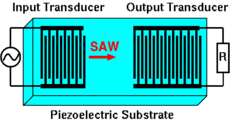Physics:Interdigital transducer
An interdigital transducer (IDT) is a device that consists of two interlocking comb-shaped arrays of metallic electrodes (in the fashion of a zipper). These metallic electrodes are deposited on the surface of a piezoelectric substrate, such as quartz or lithium niobate, to form a periodic structure.[1]
Function
IDTs primary function is to convert electric signals to surface acoustic waves (SAW) by generating periodically distributed mechanical forces via piezoelectric effect (an input transducer).
The same principle is applied to the conversion of SAW back to electric signals (an output transducer). These processes of generation and reception of SAW can be used in different types of SAW signal processing devices, such as band pass filters, delay lines, resonators, sensors, etc.
IDT was first proposed by Richard M. White and Voltmer in 1965.
References
- ↑ Difference Between Active and Passive Transducer Retrieved 13 February 2023.
- Auld, B.A. (1990). Acoustic fields and waves in solids (2nd ed.). Krieger. ISBN 978-0898747829. https://books.google.com/books?id=_2MWAwAAQBAJ&pg=PP1.
- Matthews, H. (1977). Surface wave filters: design, construction, and use. Wiley. ISBN 978-0471580300. https://books.google.com/books?id=f4C_AAAAIAAJ.
- Ristic, V.M. (1983). Principles of Acoustic Devices (2nd ed.). Wiley. ISBN 978-0471091530. https://books.google.com/books?id=pAJTAAAAMAAJ.
- Datta, S. (1986). Surface Acoustic Wave Devices. Prentice-Hall. ISBN 978-0138779115. https://books.google.com/books?id=ng9TAAAAMAAJ.
Further reading
- White, R.M.; Voltmer, F.M. (1965). "Direct piezoelectric coupling to surface elastic waves". Appl. Phys. Lett. 7 (12): 314–6. doi:10.1063/1.1754276. Bibcode: 1965ApPhL...7..314W.
- Mamishev, A.V.; Sundara-Rajan, K.; Yang, F.; Du, Y.; Zahn, M. (2004). "Interdigital sensors and transducers". Proceedings of the IEEE 92 (5): 808–845. doi:10.1109/JPROC.2004.826603. http://www.ee.washington.edu/research/seal/pubfiles/2004808805.pdf.
- Igreja, R.; Dias, C.J. (2004). "Analytical evaluation of the interdigital electrodes capacitance for a multi-layered structure". Sensors and Actuators A: Physical 112 (2–3): 291–301. doi:10.1016/j.sna.2004.01.040.
 |


